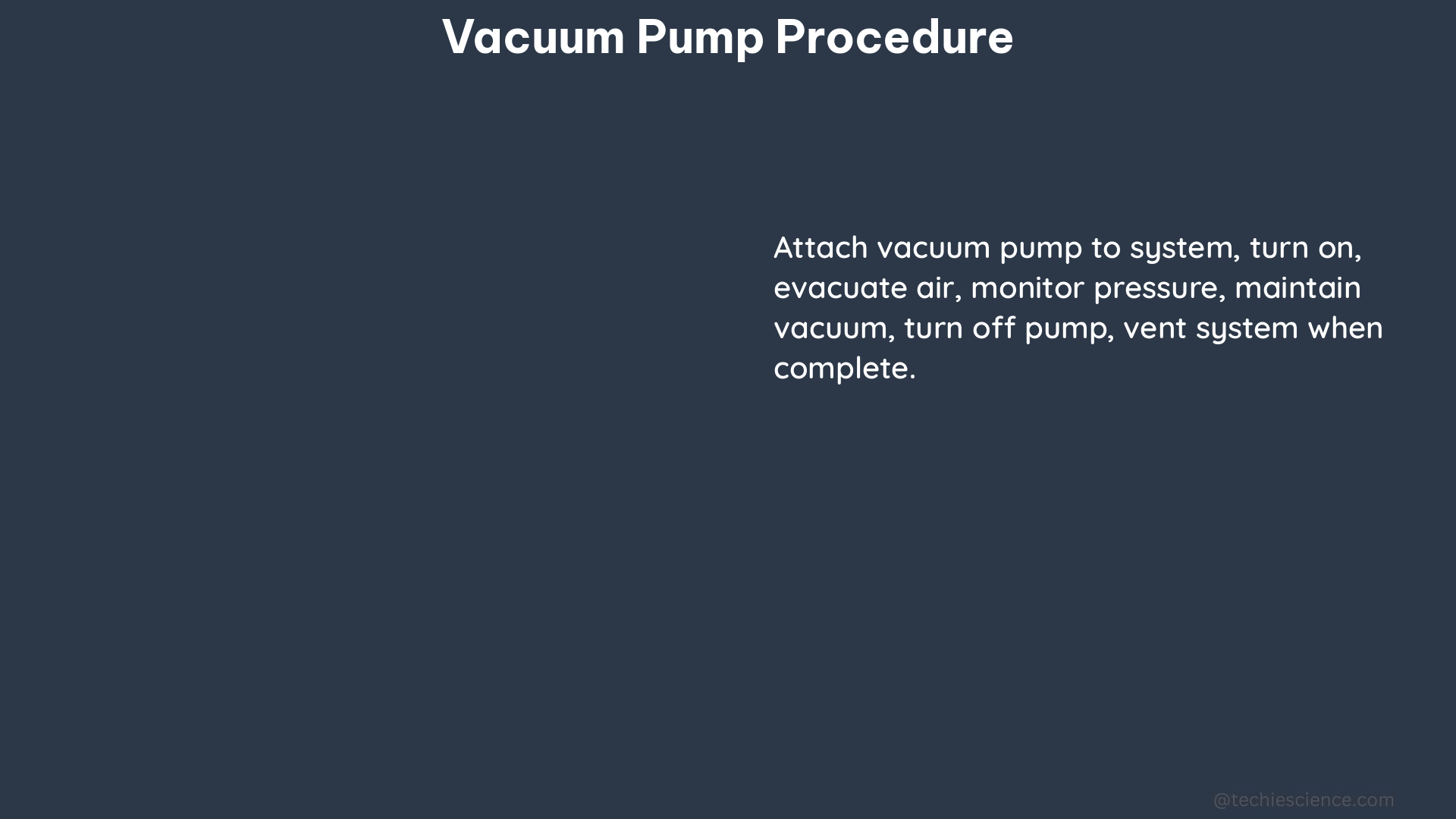Vacuum pump procedures are a critical step in maintaining and servicing various systems, from HVAC to industrial applications. This comprehensive guide will provide you with a detailed, step-by-step walkthrough of the vacuum pump procedure, including technical specifications, equipment requirements, and a DIY approach for hands-on enthusiasts.
Preparation: Ensuring a Clean and Tight System
Before initiating the vacuum pump procedure, it’s essential to ensure that the system is clean, dry, and tight. This can be achieved through the following steps:
- Nitrogen Purging: Purge the system with nitrogen to remove any contaminants or moisture. This process involves flowing nitrogen through the system while brazing any connections.
- Leak Testing: Perform pressure tests and bubble tests at all joints to verify the system’s leak-free status. The system should be able to hold a minimum of 500 PSI of dry nitrogen without any pressure drop.
Equipment: Selecting the Right Tools for the Job

Proper equipment is crucial for achieving a deep and effective vacuum. The recommended tools and equipment include:
- Vacuum Pump: Use a modern, two-stage vacuum pump capable of pulling a deep vacuum. These pumps are designed to handle the rigors of HVAC and industrial applications.
- Vacuum Hoses: Utilize large-diameter vacuum hoses (greater than 1/4″) that are specifically designed for vacuum applications, not manifold or refrigerant hoses.
- Core Remover Tool: A core remover tool is essential for connecting the vacuum pump to the system without introducing air.
- Vacuum Gauge: Invest in a high-quality vacuum gauge that can accurately measure pressure in the micron scale. This will allow you to monitor the vacuum level during the evacuation process.
- Vacuum Pump Oil: Check the vacuum pump oil level and quality regularly. If the oil appears opaque or the level is low, it’s time to change the oil.
Connection: Preparing the Vacuum Pump and System
- Micron Gauge Connection: Connect the micron gauge directly to the vacuum pump and pull the system below 50 microns to confirm that the pump is functioning correctly.
- Gas Ballast: If working on a potentially wet system, utilize the gas ballast feature on the vacuum pump to prevent oil contamination.
- System Connection: Connect the vacuum pump to the system using the core remover tool and a one-hose or two-hose setup. Attach the hose to the vacuum pump and the micron gauge to the system.
Evacuation: Pulling a Deep Vacuum
- Initial Evacuation: Start the vacuum pump and pull the system below 500 microns. This is considered a deep vacuum.
- System Isolation: Once the desired vacuum level is reached, isolate the system by shutting off the core remover tool.
Decay Test: Ensuring System Integrity
- Decay Test: Perform a decay test to ensure that the system pressure does not rise. This test involves monitoring the vacuum level over time to verify the system’s integrity.
- Acceptable Pressure Rise: An acceptable pressure rise during the decay test is no more than 100 microns per hour. If the pressure rises more than this, it indicates a potential leak in the system.
Technical Specifications
- Vacuum Levels: A deep vacuum is achieved by pulling the system below 500 microns. To put this into perspective, atmospheric pressure is equivalent to 762,000 microns, and one micron is equivalent to one-MILLIONTH of a meter of mercury column.
- Vacuum Pump Types: Modern, two-stage vacuum pumps are recommended for the best results in HVAC and industrial applications. These pumps are designed to handle the demands of deep vacuum evacuation.
- Vacuum Hoses: Use large-diameter vacuum hoses (greater than 1/4″) that are specifically designed for vacuum applications. Manifold or refrigerant hoses are not suitable for this purpose.
- Vacuum Gauges: High-quality vacuum gauges that can accurately measure pressure in the micron scale are essential for monitoring the vacuum level during the evacuation process.
DIY Approach
For those interested in a DIY approach to vacuum pump procedures, follow these steps:
- Gather Necessary Equipment: Obtain a vacuum pump, large-diameter vacuum hoses, a core remover tool, and a vacuum gauge.
- Prepare the System: Ensure the system is clean, dry, and tight. Perform pressure and bubble tests to verify the system’s leak-free status.
- Connect Equipment: Attach the vacuum pump, gauge, and hoses according to the procedure outlined above.
- Pull a Vacuum: Follow the steps to pull a deep vacuum and perform the decay test to ensure the system’s integrity.
Remember, attention to detail and the use of high-quality equipment are crucial for achieving a successful vacuum pump procedure. By following this comprehensive guide, you’ll be well on your way to mastering the art of vacuum pump maintenance and servicing.
References:
– Introduction to Vacuum Technology
– Checking the Functionality of a Vacuum Pump
– HVAC School Videos: Evacuation

The lambdageeks.com Core SME Team is a group of experienced subject matter experts from diverse scientific and technical fields including Physics, Chemistry, Technology,Electronics & Electrical Engineering, Automotive, Mechanical Engineering. Our team collaborates to create high-quality, well-researched articles on a wide range of science and technology topics for the lambdageeks.com website.
All Our Senior SME are having more than 7 Years of experience in the respective fields . They are either Working Industry Professionals or assocaited With different Universities. Refer Our Authors Page to get to know About our Core SMEs.